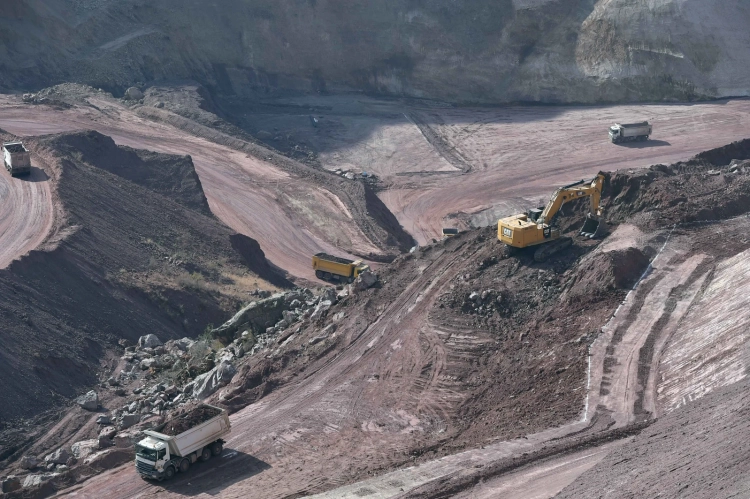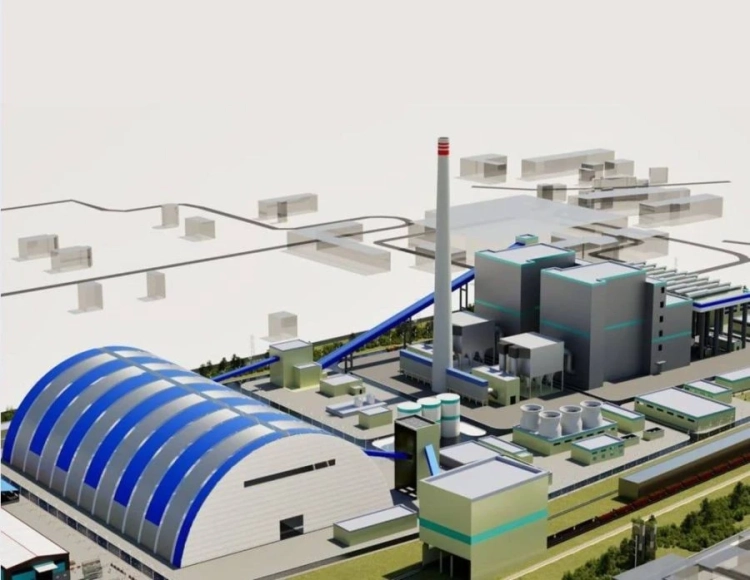The Republic has a significant amount of diverse fuel and energy resources. Involving them in production allows for gradually addressing the issues of reducing the import of energy carriers from other countries and increasing the efficiency of the fuel and energy complex, which consists of two major sectors: fuel production (coal, oil, gas extraction) and electric power generation. The fuel and energy complex represents an inter-industry system for the production of fuel and energy, including extraction, processing, transportation, distribution, and use of energy resources. The complex accounts for 19.9% of the gross industrial output (2000).
Fuel Industry. Compared to other industrial sectors, the fuel industry was established much earlier. The first coal extraction enterprises were built in southern Kyrgyzstan, in Suyluq and Kyzyl-Kiya, in the second half of the 19th century. Since 1910, coal deposits have been developed in Kök-Jangak, and since 1916 in Tash-Kömür. The volume of coal extracted in Kyrgyzstan in 1913 accounted for about 70% of the total coal output in Central Asia. The beginning of oil exploration dates back to 1900. The first oil was obtained in the Maiлуу-Suu area, with an extraction of 65 tons per year, which increased to 3000 tons by 1913. Energy extraction enterprises accounted for 50% of the total output and 59% of the workforce of the entire industrial sector of the republic. The capacities of the mines varied widely—from 50,000 to 100,000 tons of coal per year. The Kyzyl-Kiya mines produced 60.2% of the total coal output in Kyrgyzstan, Suyluq—23.3%, Kök-Jangak—10.4%, Tash-Kömür—3.0%. The government allocated 2.9 million rubles for the creation of new and the expansion of old enterprises from 1925 to 1928. In 1929-30, 17.7 million rubles were invested in the development of the coal industry. The Tash-Kömür, Almalyk, and Jyrgalan coal mines were commissioned. Coal production in 1940 increased 17 times compared to 1913.

After the Great Patriotic War, the pace of development of the fuel industry increased. In the 1970s, the coal industry had 10 mines and 2 open-pit mines with a total extraction capacity of over 4.5 million tons of coal per year. The share of coal extracted by open-pit mining accounted for 55% of the total output. The economic significance of coal deposits in the republic's fuel and energy potential is substantial. Currently (2001), there are about 100 coal deposits in the republic. Geological coal reserves amount to 31.4 billion tons, and balance reserves are 2.4 billion tons. Coal resources are unevenly distributed across the territory of the republic: 65% of coal is located in Southern Kyrgyzstan, 33% in Naryn, and 2% in Issyk-Kul regions. More than 70% of coal deposits are concentrated in the mountainous areas of the republic. Currently (2001), hard coal is extracted in Kök-Jangak, Tash-Kömür, Tegene, and Jyrgalan, while brown coal is extracted in Suyluq, Kyzyl-Kiya, Min-Kush, and Almalyk. The majority of the extracted coal is used in energy production, 32% in municipal services, and 13% for the production of construction materials. In recent years, due to the development of market relations, the fuel industry, like other sectors of the economy, has faced a temporary crisis. As a result of the lack or shortage of reliable supports from fir timber, modern mining equipment, spare parts, etc., as well as insufficient funding, the volume of coal extraction has been steadily declining each year. The coal sector, currently in a difficult situation, comprises 12 mines and open-pit mines, 5 auxiliary enterprises and organizations, and several small enterprises (1999). They employ 4,080 people. Since 1980, despite the shortage of coal, oil, and natural gas in the republic, their production has been decreasing. In 2000, coal extraction compared to 1980 decreased by 10.1 times, and compared to 1990 by 9.5 times, amounting to 415.2 thousand tons. In 2000, coal industry enterprises produced 419.4 thousand tons of coal (in 1991—3.5 million tons) worth 451.0 million soms. The Kara-Keche coal deposit (Naryn region, Jumgal district) plays a significant role in supplying fuel to the population in the northern part of the republic. Its coal reserves amount to 312.6 million tons, which is 23.3% of the total reserves of the republic. In 2000, coal production in Kyrgyzstan increased by 0.6% compared to 1999. Due to a lack of financial resources, coal extraction decreased by 3.8% at the limited liability company "Tegene" and by 86.1% at the state joint-stock company "Kök-Jangak".
From 1994 to 1999, coal extraction in the country decreased by 1.8 times, caused by the wear of equipment (90-98%) and the use of outdated extraction technology. In 1999, the production capacities of coal industry enterprises were utilized at 32.4%. The government of the republic provided state support to coal mining enterprises. From 1992 to 1997, they were allocated 25 million soms in budget loans to replenish working capital and more than 200 thousand US dollars for the acquisition of material and technical resources as part of a technical credit from the Russian Federation. Coal mining enterprises were transformed into joint-stock companies: "Suyluq-Kömür" (in 1999, product output amounted to 20,714 thousand soms), "Almalyk-Kömür" (1,608 thousand soms), "Tash-Kömür" (4,760 thousand soms), "Tegene" (2,475 thousand soms). According to an individual privatization project, the "Jyrgalan" mine (2,878 thousand soms), "Kök-Jangak" (9,595 thousand soms), and the "Ak-Ulak" open-pit mine (21,643 thousand soms) were transformed into joint-stock companies. In 1999, the coal sector received state support for replenishing working capital—19.0 million soms, as well as 22 million soms for the development of the state joint-stock company "Ak-Ulak" open-pit mine, and the "State Program for the Development of the Coal Industry until 2005" was adopted, which provides for the commissioning of capacities at the "Kara-Keche" open-pit mine, increasing coal extraction to 1.0 million tons per year. An increase in coal extraction to 1,512 thousand tons is planned.

Despite the presence of numerous coal deposits in the republic, a large portion of the consumed coal is currently imported from Kazakhstan (Karaganda). The future of the coal industry is linked to the extent of development of sufficient promising, yet unexplored coal deposits, among which the economically significant Kabak brown coal basin holds an important place (geological coal reserves amount to 800 million tons). The most promising deposit in this basin is the Kara-Keche, where coal extraction is increasing annually. Comprehensive development of this deposit requires the construction of a railway. In the southern part of the republic, the Uzgen coal basin has over 30 deposits, with total hard coal reserves of 2.2 billion tons, more than half of which is coking coal. The difficulty of developing this basin lies in the high mountainous terrain and the lack of a railway.
The fuel industry also includes gas and oil extraction sectors. There are 12 oil fields located in the Jalal-Abad region. In 2000, 77 thousand tons of gas (including gas condensate) were produced here.
Oil production in the republic in 1999 decreased by 2.8 times compared to 1980, and more than 2 times compared to 1990, amounting to 76.9 thousand tons. Currently, 90% of the oil extracted comes from the Izbasken, Chanyr-Tash, Maiлуу-Suu, and East-Izbasken fields. In 1940, 24 thousand tons of oil were extracted, in 1950—47 thousand tons, in 1960—464.0 thousand tons, in 1970—298.1 thousand tons, in 1999—77.0 thousand tons, and in 2000—77.0 thousand tons. Near the city of Jalal-Abad, a refinery with a capacity of 0.5 million tons was built with the participation of other countries. Exploratory work is underway to search for new oil deposits. The industrial oil reserves are small, amounting to 14.6 million tons. The decline in oil production is associated with the lack of oil refineries, equipment wear, etc. The joint venture "Kyrgyz Petroleum Company" produced 61.8 thousand tons of gasoline and 45.5 thousand tons of diesel fuel in 1999. In the republic in 1999, a total of 46.4 thousand tons (in 1997—37.6 thousand tons) of fuel oil, 53.7 thousand tons (1997, 28.1 thousand tons) of diesel fuel, and 72.5 thousand tons (1997, 164.6 thousand tons) of automotive gasoline were produced.

The oil and gas complex does not meet the needs of the republic for oil and natural gas, hence the necessity to import them from Russia, Kazakhstan, and Uzbekistan.
Industrial gas reserves are also small—5 billion m³. In 1999, 25.1 million m³ of gas were produced, and in 2000—31.9 million m³. Gas extraction in 1999 decreased by 5.2 times compared to 1980, and by 3.8 times compared to 1990. In the southern part of the republic, the Maiлуу-Suu—Jalal-Abad—Osh gas pipeline has been constructed, and the Bukhara—Tashkent—Chimkent—Zhambyl—Almaty gas pipeline is connected to the Bishkek—Tokmok gas pipeline. The purchase of gas from other countries at high prices creates complex economic problems for the republic.













































